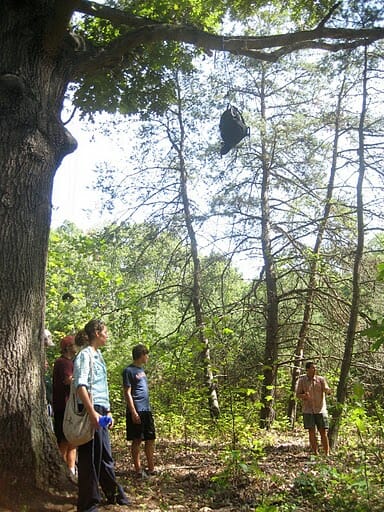Skills & Techniques
Respect Wildlife: Food storage and easy steps for hanging a bear bag


As camping and hiking season rapidly approaches, it’s important to remember how we can minimize our impact on the wildlife that we encounter in the outdoors—particularly with regards to food and trash. In parks and protected areas where there are food storage facilities such as bear boxes, it’s as simple as putting your food, trash, and smellable items into the box and making sure it’s properly latched.
When camping in more remote areas or areas with no onsite bearproof food storage facilities, we have to use a different set of skills to ensure that our food, trash, and other smellable items are stored properly. These items can cause many problems for wildlife, particularly bears. When wildlife obtains, becomes accustomed to, and seeks out human foods and trash they can quickly lose their natural instincts, such as foraging or hunting. You will have a much more enjoyable and safer trip if your food, trash, and smellables are all kept out of reach of animals!
One of the easiest methods for storing food, trash, and smellable items is to use an approved bearproof canister. There are numerous models that have been approved for use by various land management agencies, so be sure to check local rules and regulations for proper food storage prior to your trip. Many ranger stations offer bear canisters for rent or for free in some cases. They can also be rented from outdoor equipment stores. Lastly, be sure and practice packing your bear canister at home before you head into the woods to make sure it will accommodate EVERYTHING you intend to put inside of it.
If bear canisters are not required, one method for properly storing food, trash and other smelly items is called a bear bag hang. Be sure and check local rules and regulations as some areas do not allow the use of bear bags. If bear bag hangs are allowed, here the steps to successfully completing a single tree hang:
- First make sure you have equipment you need, which includes: durable bags—nylon stuff sacks work well; at least 50 ft of rope; carabiners—these will help you clip your bags together and on to the rope.
- Gather all of your smellable items to store in the bags. This includes food, trash, dirty dishes and cookware, deodorant, toothpaste, bug repellant, etc.
- Choose a tree that is 200+ ft. away from the cooking and sleeping areas of your campsite. Ideally, the cooking, sleeping and bear bag areas will form a triangle with 200ft. along each side.
- Choose a tree with a sturdy branch that will all you to hoist the bag(s) a minimum of 12 ft. off the ground, and a minimum of 6 ft. from the trunk of the tree or the nearest branch.
- Attach a rock to one end of the rope and throw over the branch, making sure it is 6 ft or more from the trunk. This may take a few tries. Remember, safety is important, so make sure to clear the area of people when throwing the rock.
- A variety of knots can be used at the end of the rope to attach the bag(s). Then clip the bags together and to the knot using your carabineers. Hoist the bags into the air—again, a minimum of 12 ft. up and 6 ft. out from the trunk or nearest branch. You may need a friend or two to help with this part.
- Tie the free end of the rope to the tree, making sure it is secure and will not become undone overnight.
Remember, this bear bag hang is just one way you can properly store your food, trash and other smelly items during an overnight camping trip in the backcountry. While bear bags are allowed in some areas, bear canisters are generally easier to use and more effective. However, if you plan to use a bear bag hang, practice at home to ensure you can actually do a correct hang before going into the backcountry. By following these steps, and using a few pieces of equipment, you can do your part to Respect Wildlife.
Related Blog Posts
Let’s protect and enjoy our natural world together
Get the latest in Leave No Trace eNews in your inbox so you can stay informed and involved.

